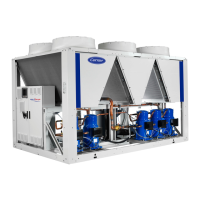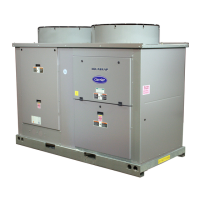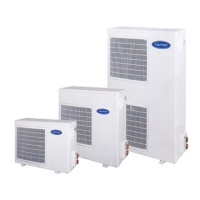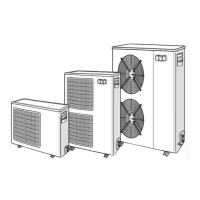31
The demand limit is used to restrict the unit power consump-
tion. The Pro-Dialog control system allows limitation of
the unit capacity, using one of two methods:
• by means of user-controlled volt-free contacts. The
units without energy management option only have one
demand limit level (only one contact: control contact 3).
The units equipped with energy management option
permit three demand limit levels (2 contacts). The unit
capacity can never exceed the limit setpoint activated
by these contacts. The limit setpoints can be modified
in the setpoint menu.
• by means of a 4-20 mA input type on the energy manage-
ment board. The limit is now based on a linear interpo-
lation from 0 to 100%, based on the input signal. The
demand limit in night mode is selectable (if the value
is below the one controlled by the external signal).
The night period is defined (see User configuration) by a
start time and an end time that are the same for each day
of the week. During the night period, the number of fans
operating can be reduced, and the unit capacity may be
limited (but a minimum capacity value can be configured).
This function adjusts the number of active compressors to
keep the heat exchanger water temperature at its setpoint.
The precision with which this is achieved depends on the
capacity of the water loop, the flow rate, the load, and the
number of stages available on the unit. The control system
continuously takes account of the temperature error with
respect to the setpoint, as well as the rate of change in this
error and the difference between entering and leaving
water temperatures, in order to determine the optimum
moment at which to add or withdraw a capacity stage. If the
same compressor undergoes too many starts (per hour) or
runs below one minute each time it is started this automa-
tically brings about reduction of compressor starts, which
makes leaving water temperature control less precise. In
addition, the high pressure, low pressure or defrost unloading
functions can also affect the temperature control accuracy.
Compressors are started and stopped in a sequence designed
to equalise the number of start-ups (value weighted by
their operating time).
The head pressure is controlled by a maximum of six fans.
As an option, a variable-speed controller can control one or
all of the fans. The head pressure is independently controlled
for each circuit, based on the saturated condensing tempe-
rature value.
Fan start-up:
ATTENTION: The fans can be started periodically (for
cleaning), even if the unit is switched off.
Defrost is activated, when the unit is in heating mode, in
order to reduce frost build-up on the air heat exchanger.
The defrost cycle can only be applied to one circuit at a
time. During the defrost cycle the fans of that circuit are
stopped, and the four-way refrigerant valve is reversed,
forcing the circuit to cooling mode. The fan can temporarily
be restarted during the defrost cycle. The defrost cycle is
fully automatic and does not require any setting.
The heat pump units can control up to four additional
electric heating stages.
The electric heating stages are activated to complement the
heating capacity when the following conditions are satisfied:
• The unit uses 100% of the available heating capacity,
or the unit is limited in its operation by a protection
mode (low suction temperature, hot gas or defrost
sequence in progress protection), and in all cases
cannot satisfy the heating load.
• The outdoor temperature is below a configured threshold
(see User 1 configuration).
• The unit demand limit is not active.
The user may configure the last available electric heating
stages as a safety stage. In this case, the safety stage is only
activated in addition to the other stages if there is a machine
fault, preventing the use of the heating capacity. The other
electric heating stages will continue to operate as described
above.
NOTE: The control of the electric heating stages or of a
boiler is not authorised for slave units.
The unit can control the start-up of a boiler, if it is in heating
mode. When the boiler is operating, the unit water pump is
stopped.
A heat pump unit and a boiler cannot operate together. In
this case the boiler output is activated in the following
conditions:
• The unit is in heating mode, but a fault prevents the
use of the heat pump capacity.
• The unit is in heating mode, but works at a very low
outdoor temperature, making the heat pump capacity
insufficient. The outdoor air temperature threshold
for use of the boiler is fixed at -10°C, but this value
can be adjusted in the User 1 menu.
Two PRO-DIALOG Plus units can be linked to produce a
master/slave assembly. The two machines are interconnected
over the CCN bus. All parameters required for the master/
slave function must be configured through the Service
configuration menu. Master/slave operation requires the
connection of a temperature probe at the common manifold
on each machine, if the heat exchanger leaving water
temperature is controlled.

